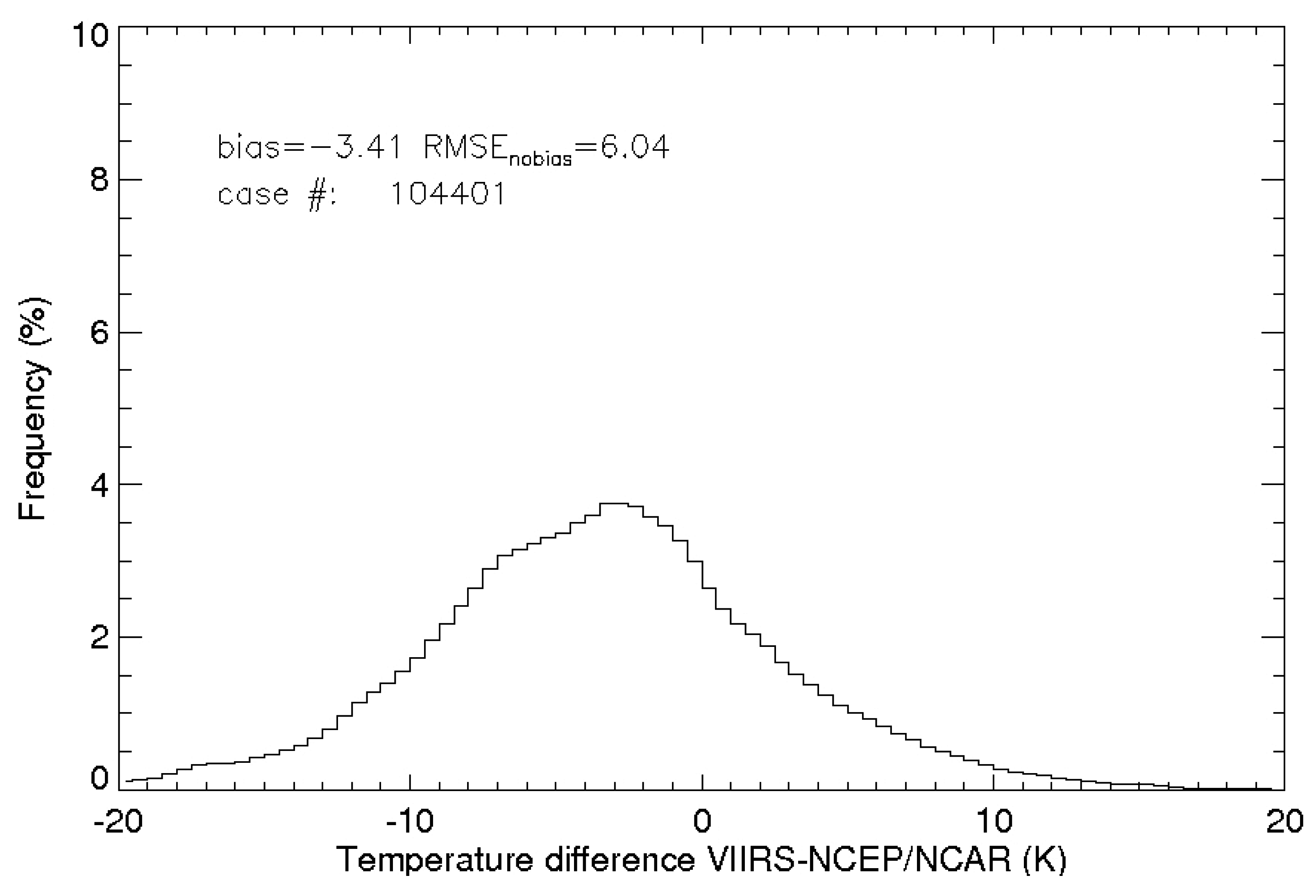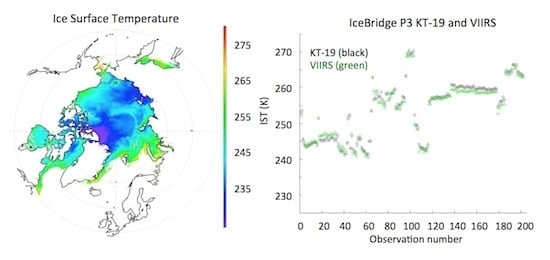Validation of the Suomi NPP VIIRS Ice Surface Temperature Environmental Data Record
Abstract
:1. Introduction

2. Data and Methods
2.1. Validation Datasets
| Validation Dataset | Parameter | Spatial Resolution | Spatial Coverage | Temporal Coverage |
|---|---|---|---|---|
| NASA IceBridge KT-19 IR Surface Temperature | Snow/ice temperature | 15 × 15 m | Arctic and Antarctic | Arctic: 2012–2014 Antarctic: 2012–2013 |
| MODIS Ice Surface Temperature | Snow/ice temperature | 1 km | Arctic and Antarctic | August 2012–July 2015 |
| MODIS simultaneous nadir overpass | Snow/ice temperature | 0.05 degree longitude by 0.05 degree latitude | Arctic | March 2013–April 2014 |
| Arctic drifting buoy | 2 m air temperature | Point observations | Arctic | August 2012–June 2014 |
| NCEP/NCAR reanalysis | Air temperature at 0.995 sigma level | 2.5 × 2.5 degree latitude/longitude | Arctic and Antarctic | August 2012–July 2015 |
2.2. Definition of Statistics
3. IST Validation Results
3.1. Comparison with MODIS IST



3.2. Validation with KT-19 IST



3.3. Comparison with Drifting Buoy 2 m Air Temperature
3.4. Comparison with NCEP/NCAR Surface Air Temperature



4. Summary and Conclusions
Acknowledgments
Author Contributions
Conflicts of Interest
References
- IPCC. Climate Change 2014: Impacts, Adaptation, and Vulnerability. Part B: Regional Aspects. Contribution of Working Group II to the Fifth Assessment Report of the Intergovernmental Panel on Climate Change; Barros, V.R., Field, C.B., Dokken, D.J., Mastrandrea, M.D., Mach, K.J., Bilir, T.E., Chatterjee, M., Ebi, K.L., Estrada, Y.O., Genova, R.C., et al., Eds.; Cambridge University Press: Cambridge, UK; New York, NY, USA, 2014; p. 688. [Google Scholar]
- Francis, J.A.; White, D.M.; Cassano, J.J.; Gutowski, W.J., Jr.; Hinzman, L.D.; Holland, M.M.; Steele, M.A.; Voeroesmarty, C.J. An arctic hydrologic system in transition: Feedbacks and impacts on terrestrial, marine, and human life. J. Geophys. Res. Biogeosci. 2009, 114. [Google Scholar] [CrossRef]
- Solomon, S.; Qin, D.; Manning, M.; Chen, Z.; Marquis, M.; Averyt, K.B.; Tignor, M.; Miller, H.L.; IPCC. Summary for policymakers. In Climate Change 2007: The Physical Science Basis; Technical Report, Contribution of Working Group I, II and III to the Fourth Assessment Report of the Intergovernmental Panel on Climate Change; Cambridge University Press: Cambridge, UK; New York, NY, USA, 2007; p. 22. [Google Scholar]
- Holland, M.M.; Bitz, C.M. Polar amplification of climate change in coupled models. Clim. Dyn. 2003, 21, 221–232. [Google Scholar] [CrossRef]
- Key, J.; Haefliger, M. Arctic ice surface-temperature retrieval from AVHRR thermal channels. J. Geophys. Res. Atmos. 1992, 97, 5885–5893. [Google Scholar] [CrossRef]
- Key, J.R.; Collins, J.B.; Fowler, C.; Stone, R.S. High-latitude surface temperature estimates from thermal satellite data. Remote Sens. Environ. 1997, 61, 302–309. [Google Scholar] [CrossRef]
- Wang, X.; Key, J.R. Recent trends in arctic surface, cloud, and radiation properties from space. Science 2003, 299, 1725–1728. [Google Scholar] [CrossRef] [PubMed]
- Wang, X.; Key, J.R. Arctic surface, cloud, and radiation properties based on the AVHRR polar pathfinder dataset. Part I: Spatial and temporal characteristics. J. Clim. 2005, 18, 2558–2574. [Google Scholar] [CrossRef]
- Wang, X.; Key, J.R. Arctic surface, cloud, and radiation properties based on the AVHRR polar pathfinder dataset. Part II: Recent trends. J. Clim. 2005, 18, 2575–2593. [Google Scholar] [CrossRef]
- Liu, Y.; Key, J.; Wang, X. Influence of changes in sea ice concentration and cloud cover on recent arctic surface temperature trends. Geophys. Res. Lett. 2009, 36. [Google Scholar] [CrossRef]
- Liu, Y.; Key, J.; Wang, X. The influence of changes in cloud cover on recent surface temperature trends in the arctic. J. Clim. 2008, 21, 705–715. [Google Scholar] [CrossRef]
- Hall, D.K.; Key, J.R.; Casey, K.A.; Riggs, G.A.; Cavalieri, D.J. Sea ice surface temperature product from MODIS. IEEE Trans. Geosci. Remote Sens. 2004, 42, 1076–1087. [Google Scholar] [CrossRef]
- Duan, S.-B.; Li, Z.-L. Intercomparison of operational land surface temperature products derived from MSG-SEVIRI and Terra/Aqua-MODIS data. IEEE J. Sel. Top. Appl. Earth Observ. Remote Sens. 2015, 8, 4163–4170. [Google Scholar] [CrossRef]
- Guillevic, P.C.; Privette, J.L.; Coudert, B.; Palecki, M.A.; Demarty, J.; Ottle, C.; Augustine, J.A. Land surface temperature product validation using NOAA’s surface climate observation networks-scaling methodology for the visible infrared imager radiometer suite (VIIRS). Remote Sens. Environ. 2012, 124, 282–298. [Google Scholar] [CrossRef]
- Wan, Z.; Li, Z.L. Radiance-based validation of the v5 MODIS land-surface temperature product. Int. J. Remote Sens. 2008, 29, 5373–5395. [Google Scholar] [CrossRef]
- Li, Z.L.; Tang, B.H.; Wu, H.; Ren, H.; Yan, G.; Wan, Z.; Trigo, I.F.; Sobrino, J.A. Satellite-derived land surface temperature: Current status and perspectives. Remote Sens. Environ. 2013, 131, 14–37. [Google Scholar] [CrossRef]
- Cao, C.; Xiong, J.; Blonski, S.; Liu, Q.; Uprety, S.; Xi, S.; Yan, B.; Weng, F. Suomi NPP VIIRS sensor data record verification, validation, and long-term performance monitoring. J. Geophys. Res. Atmos. 2013, 118, 664–678. [Google Scholar] [CrossRef]
- Key, J.R.; Mahoney, R.; Liu, Y.; Romanov, P.; Tschudi, M.; Appel, I.; Maslanik, J.; Baldwin, D.; Wang, X.; Meade, P. Snow and ice products from Suomi NPP VIIRS. J. Geophys. Res. Atmos. 2013, 118, 12816–12830. [Google Scholar] [CrossRef]
- Yu, Y.; Rothrock, D.A.; Lindsay, R.W. Accuracy of sea-ice temperature derived from the advanced very high-resolution radiometer. J. Geophys. Res.: Oceans 1995, 100, 4525–4532. [Google Scholar] [CrossRef]
- Hutchison, K.D.; Roskovensky, J.K.; Jackson, J.M.; Heidinger, A.K.; Kopp, T.J.; Pavolonis, M.J.; Frey, R. Automated cloud detection and classification of data collected by the visible infrared imager radiometer suite (VIIRS). Int. J. Remote Sens. 2005, 26, 4681–4706. [Google Scholar] [CrossRef]
- Comiso, J.C. Surface temperatures in the polar-regions from Nimbus-7 temperature humidity infrared radiometer. J. Geophys. Res.: Oceans 1994, 99, 5181–5200. [Google Scholar] [CrossRef]
- Lindsay, R.W.; Rothrock, D.A. Arctic sea-ice surface-temperature from AVHRR. J. Clim. 1994, 7, 174–183. [Google Scholar] [CrossRef]
- Baker, N. Joint Polar Satellite System (JPSS) VIIRS Ice Surface Temperature Algorithm Theoretical Basis Document Rev-A. Available online: http://npp.gsfc.nasa.gov/sciencedocs/2015-06/474-00052_ATBD-VIIRS-IST_A.pdf (accessed on 1 May 2013).
- Ip, J.; Hauss, B. Pre-launch performance assessment of the VIIRS ice surface temperature algorithm. In Proceedings of the Fifth Annual Symposium on Future Operational Environmental Satellite Systems-NPOESS and GOES-R; 16th Conference on Satellite Meteorology and Oceanography; 89th Annual Meeting of the American Meteorological Society 89th, Phoenix, AZ, USA, 11–15 January 2009.
- Baker, N. Joint Polar Satellite System (JPSS) NPP Operational Algorithm Proxy and Synthetic Test Data Description. Available online: http://www.star.nesdis.noaa.gov/jpss/documents/OAD/GSFC_474-00096_JPSS_NPP_Operational_Algorithm_Proxy_and_Synthetic_Test_Data__Alt._doc._no._D45702_.pdf (accessed on 3 January 2012).
- Shoucri, M.; Hauss, B. Everest: An end-to-end simulation for assessing the performance of weather data products produced by environmental satellite systems. Proc. SPIE 2009, 7458, 74580G. [Google Scholar]
- Berk, A.; Anderson, G.P.; Acharya, P.K.; Bernstein, L.S.; Muratov, L.; Lee, J.; Fox, M.; Adler-Golden, S.M.; Chetwynd, J.H.; Hoke, M.L. MODTRAN5: 2006 Update. Proc. SPIE 2006, 6233, 62331F. [Google Scholar]
- Mills, S. Simulation and test of the VIIRS Sensor Data Record (SDR) algorithm for NPOESS. In Proceedings of the Third Symposium on Future National Operational Environmental Satellites; 87th AMS Annual Meeting, San Antonio, TX, USA, 13–18 January 2007.
- Hall, D.K.; Riggs, G. MODIS/Terra Sea Ice Extent 5-Min L2 Swath 1km, Version 6; NASA National Snow and Ice Data Center Distributed Active Archive Center: Boulder, CO, USA, 2015. [Google Scholar]
- Hall, D.K.; Riggs, G.A. MODIS/Aqua Sea Ice Extent 5-Min L2 Swath 1 km, Version 6; NASA National Snow and Ice Data Center Distributed Active Archive Center: Boulder, CO, USA, 2015. [Google Scholar]
- Baker, N. Joint Polar Satellite System (JPSS) Operational Algorithm Description (OAD) for VIIRS Sea Ice Concentration Intermediate Product (IP) Software. Available online: http://npp.gsfc.nasa.gov/sciencedocs/2015-06/474-00094_OAD-VIIRS-SIC-IP_B.pdf (accessed on 3 June 2013).
- Krabill, W.B.; Buzay, E. IceBridge KT-19 IR Surface Temperature, Version 1. (2012–2015); Updated 2014; NASA National Snow and Ice Data Center Distributed Active Archive Center: Boulder, CO, USA, 2012. [Google Scholar]
- Studinger, M.; Koenig, L.; Martin, S.; Sonntag, J. Operation IceBridge: Using instrumented aircraft to bridge the observational gap between icesat and ICESat-2. In Proceedings of 2010 IEEE International, Geoscience and Remote Sensing Symposium (IGARSS), Honolulu, HI, USA; 2010; pp. 1918–1919. [Google Scholar]
- Kalnay, E.; Kanamitsu, M.; Kistler, R.; Collins, W.; Deaven, D.; Gandin, L.; Iredell, M.; Saha, S.; White, G.; Woollen, J.; et al. The NCEP/NCAR 40-year reanalysis project. Bull. Am. Meteorol. Soc. 1996, 77, 437–471. [Google Scholar] [CrossRef]
- Rigor, I.G.; Colony, R.L.; Martin, S. Variations in surface air temperature observations in the arctic, 1979–1997. J. Clim. 2000, 13, 896–914. [Google Scholar] [CrossRef]
- Scambos, T.A.; Haran, T.M.; Massom, R. Validation of AVHRR and MODIS ice surface temperature products using in situ radiometers. Ann. Glaciol. 2006, 44, 345–351. [Google Scholar] [CrossRef]
- Dee, D.P.; Uppala, S.M.; Simmons, A.J.; Berrisford, P.; Poli, P.; Kobayashi, S.; Andrae, U.; Balmaseda, M.A.; Balsamo, G.; Bauer, P.; et al. The ERA-Interim reanalysis: Configuration and performance of the data assimilation system. Q. J. R. Meteorol. Soc. 2011, 137, 553–597. [Google Scholar] [CrossRef]
- Kanamitsu, M.; Ebisuzaki, W.; Woollen, J.; Yang, S.K.; Hnilo, J.J.; Fiorino, M.; Potter, G.L. NCEP-DOE AMIP-II reanalysis (R-2). Bull. Am. Meteorol. Soc. 2002, 83, 1631–1643. [Google Scholar] [CrossRef]
- Radionov, V.F.; Bryazgin, N.N.; Alexandrov, E.I. The Snow Cover of the Arctic Basin; Technical Report, APL-UW TR 9701; Applied Physics Laboratory, University of Washington: Seattle, WA, USA, 1997. [Google Scholar]
© 2015 by the authors; licensee MDPI, Basel, Switzerland. This article is an open access article distributed under the terms and conditions of the Creative Commons by Attribution (CC-BY) license (http://creativecommons.org/licenses/by/4.0/).
Share and Cite
Liu, Y.; Key, J.; Tschudi, M.; Dworak, R.; Mahoney, R.; Baldwin, D. Validation of the Suomi NPP VIIRS Ice Surface Temperature Environmental Data Record. Remote Sens. 2015, 7, 17258-17271. https://doi.org/10.3390/rs71215880
Liu Y, Key J, Tschudi M, Dworak R, Mahoney R, Baldwin D. Validation of the Suomi NPP VIIRS Ice Surface Temperature Environmental Data Record. Remote Sensing. 2015; 7(12):17258-17271. https://doi.org/10.3390/rs71215880
Chicago/Turabian StyleLiu, Yinghui, Jeffrey Key, Mark Tschudi, Richard Dworak, Robert Mahoney, and Daniel Baldwin. 2015. "Validation of the Suomi NPP VIIRS Ice Surface Temperature Environmental Data Record" Remote Sensing 7, no. 12: 17258-17271. https://doi.org/10.3390/rs71215880
APA StyleLiu, Y., Key, J., Tschudi, M., Dworak, R., Mahoney, R., & Baldwin, D. (2015). Validation of the Suomi NPP VIIRS Ice Surface Temperature Environmental Data Record. Remote Sensing, 7(12), 17258-17271. https://doi.org/10.3390/rs71215880







